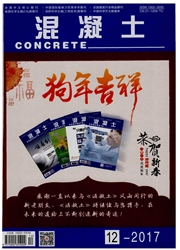

 中文摘要:
中文摘要:
C30和C50引气混凝土在3.5%NaCl以及5%Na2SO4+3.5%NaCl溶液中自然浸泡或快速冻融循环,测试盐冻过程中混凝土的自由氯离子和总氯离子。结果表明:冻融循环不改变混凝土中氯离子传输规律,仍符合Fick第二扩散定律。腐蚀初期,浸泡环境下混凝土的氯离子浓度高于冻融环境,但随混凝土冻融损伤程度增加,趋势相反。氯盐环境下冻融,混凝土氯离子结合能力随龄期增加而下降;但在氯盐溶液中浸泡,混凝土氯离子结合能力随龄期增加而增加。复合盐溶液中硫酸根离子存在导致浸泡环境下混凝土氯离子结合能力随龄期增加而下降。
 英文摘要:
英文摘要:
The free chloride ion, total chloride ion distribution and calculated chloride binding capacity of concrete under attack of salt frost are systematically investigated.The compressive strength grade of air entrainment concrete is C30 and C50.The corrosion regimes are employed in this study: freeze-thaw cycles in 3.5% NaCl solution or in5%Na2SO4+3.5%NaCl, and naturally immersion( stored in corrosion solution with same time of freeze-thaw cycles ).The experimental results show that the rule of chloride transported in concrete exposed to salt frost environment is followed from the Fick's 2nd law.The free and total chloride content of concrete stored in NaCl solution is higher than that of concrete exposed to salt frost in the initial corrosion stage, but the trend is exactly opposite in the later corrosion stage, espe-cially in serious frost damage period.When concrete frosted in NaCl solution,its chloride binding capacity decreases with corrosion time. And when concrete immersed into chloride solution, its chloride binding capacity increases with time.Additionally, sulfate ion in corrosion solution results in that the chloride binding capacity of concrete decreases with time.
 同期刊论文项目
同期刊论文项目
 同项目期刊论文
同项目期刊论文
 Damage of cement paste in sulfate environment with different temperature and drying-immersion cycles
Damage of cement paste in sulfate environment with different temperature and drying-immersion cycles Corrosive Crack and its 3D Defects Identification of Reinforced Concrete Subjected to Coupled Effect
Corrosive Crack and its 3D Defects Identification of Reinforced Concrete Subjected to Coupled Effect Aqueous processing and effects of V2O5 on microwave dielectric properties of multilayer Li1.075Nb0.6
Aqueous processing and effects of V2O5 on microwave dielectric properties of multilayer Li1.075Nb0.6 期刊信息
期刊信息
